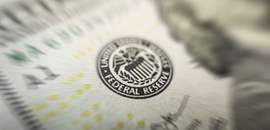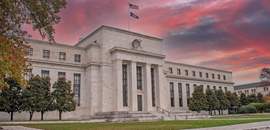Signals of Monetary Policy Change
Before the recent Federal Open Market Committee (FOMC) meeting in December, investors were optimistic about the Fed easing policy in 2024, and the bond market was pricing in rate cuts of a whole percentage point, 4.25 percent to 4.5 percent, by the end of the year.
The Fed did not disappoint investors this time when it signaled it was close to pivoting monetary policy. Nick Timiraos of The Wall Street Journal notes this represented a dramatic change in Chair Jerome Powell’s stance from two weeks prior when he stated, “It would be premature to … speculate on when policy might ease.” Following the FOMC meeting, Powell said that rate cuts were “coming into view” and “clearly a topic of discussion.”
The principal reason is officials are more confident that inflation is on the path toward its 2 percent target in the wake of a series of benign readings. The median expectation of Fed officials in the December FOMC projections calls for the core rate of personal consumption expenditures to fall to 2.4 percent next year from 3.2 percent this year.
Rate Cuts & Market Rallies
The “dot plot” indicates that most participants anticipate three rate cuts of one-quarter point each in 2024. Additional cuts totaling 175 basis points are expected in the next two years, such that the fund rate would fall below 3 percent by the end of 2026.
This news spurred large rallies in both the stock and bond markets. The Dow Jones Industrial Average set a record high above 37,000 while the 10-year Treasury yield fell below 4 percent. As a result, the bond market is now pricing in rate cuts of about 150 basis points in the coming year — two more cuts than were expected before the meeting.
Economic Projections
The Fed’s projections for the economy implicitly assume there will be a “soft landing.” Unemployment is expected to rise only marginally in the next two years to 4.1 percent, while the pace of economic growth is projected to moderate from 2.5 percent this year to 1.4 percent next year before reverting to its long-term trend of 1.8 percent per annum.
One issue Fed officials have not addressed explicitly, however, is how they would respond if a recession were to unfold. Powell acknowledged in the FOMC press conference that this remains a possibility because the large rate increases over the past two years have weakened housing and business investment. Consumer fundamentals also show some signs of deterioration as household savings have depleted.
One reason investors expect the Fed to move aggressively is their awareness of its behavior over the past two decades: The Fed has been quick to lower interest rates to zero when a recession materializes and the financial system is at risk. However, it has been slow to tighten when an expansion is underway.
Unconventional Policies: Response During Financial Crises
During the 2008 financial crisis, the Fed adopted “unconventional policies,” such as quantitative easing, which quadrupled its balance sheet to stabilize the financial system. The Fed then repeated these actions when the economy slumped at the onset of the COVID-19 pandemic, even though the economy rebounded soon after businesses reopened.
The basis for doing so was outlined in a new strategic framework in 2020 that set a flexible average annual inflation target of 2 percent. At that time, the Fed was concerned about the risk of deflation, and the new framework allowed it to tolerate inflation overshoots following periods of undershoots. The new policy framework represented a significant departure from the Fed’s strategy in 2012, which established a balanced approach for its dual mandate of price stability and full employment.
In a Wall Street Journal op-ed, Mickey Levy and Charles Plosser argued that the new framework was misguided and eschewed preemptive monetary tightening just when higher inflation appeared imminent. They stated, “The benefits of the Fed’s balanced approach were cast aside for asymmetries and greater reliance on the Fed’s discretion and judgment.”
Only during the past two years has the Fed significantly raised interest rates and begun to shrink its balance sheet as consumer price index inflation surged to 9 percent.
Given what transpired, Fed officials need to clarify the lessons to be drawn from the recent experience. While they have reaffirmed their commitment to controlling inflation, they have not provided clear guidance on how they will balance the twin objectives of price stability and maximum employment going forward. With the next review of its policy framework not scheduled until 2025, Fed policymakers must assess the experience with “unconventional” monetary policies before then.
Lessons from the Past & Caution for the Future
My take is that while ultra-low interest rates and quantitative easing may have lessened the impact of recessions, they also contributed to significant capital market distortions. The policy of keeping interest rates artificially low in the mid-2000s ultimately led to the housing bubble that was the precursor of the 2008 financial crisis. Thereafter, real interest rates were consistently low-to-negative until this past year, and investors were incented to stretch for yield and add riskier assets to their portfolios.
With inflation still somewhat above the Fed’s target and unemployment low, the Federal Reserve should resist the temptation to revert to unconventional policies if the economy softens and the stock market sells off.
The good news is that with interest rates now positive in real terms, the Fed has ample room for maneuver without having to go full throttle.
A version of this article was posted to TheHill.com on December 14, 2023.
This publication has been distributed for informational purposes only and should not be considered as investment advice or a recommendation of any particular security, strategy, or investment product. Opinions expressed in this commentary reflect subjective judgments of the author based on the current market conditions at the time of writing and are subject to change without notice. Information and statistics contained herein have been obtained from sources believed to reliable but are not guaranteed to be accurate or complete. Past performance is not indicative of future results. © 2023 Fort Washington Investment Advisors, Inc.































